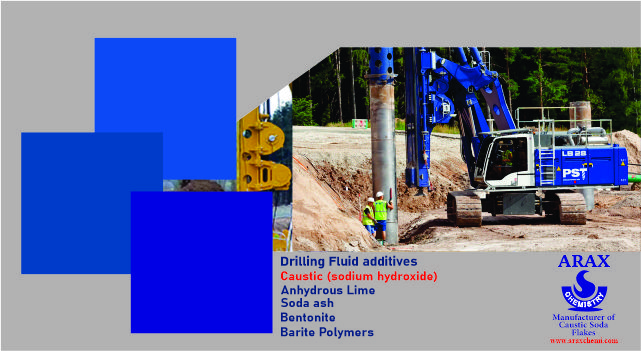Caustic Soda in Drilling Mud
Caustic Soda in Drilling Mud:
Drilling mud(drilling Fluid), in petroleum engineering, is a heavy, viscous fluid mixture. It is used in oil and gas drilling operations to carry rock cuttings to the surface. The drilling mud, by hydrostatic pressure, also helps prevent the collapse of unstable strata into the borehole, and the intrusion of water from water-bearing strata that may be encountered.
Drilling muds are traditionally based on water, either freshwater, seawater, naturally occurring brines, or prepared brines. Many muds are oil-based, using direct products of petroleum refining such as diesel oil or mineral oil as the fluid matrix. In addition, various so-called synthetic-based muds are prepared using highly refined fluid compounds that are made to more-exacting property specifications than traditional petroleum-based oils. generally, water-based muds are satisfactory for the less-demanding drilling of conventional vertical wells at medium depths. oil-based muds are better for greater depths or in directional or horizontal drilling. they place greater stress on the drilling apparatus. Synthetic-based muds were developed in response to environmental concerns over oil-based fluids, though all drilling muds are highly regulated in their composition, and in some cases, specific combinations are banned from use in certain environments.
Drilling Fluid additives
A typical water-based drilling mud contains a clay, usually bentonite, to give it enough viscosity to carry cutting chips to the surface, as well as a mineral such as barite (barium sulfate) to increase the weight of the column enough to stabilize the borehole.

Caustic Soda in Drilling Mud
Smaller quantities of hundreds of other ingredients might be added, such as caustic soda (sodium hydroxide) to increase alkalinity and decrease corrosion. salts such as potassium chloride to reduce infiltration of water from the drilling fluid into the rock formation, and various petroleum-derived drilling lubricants. Oil- and synthetic-based muds contain water, bentonite, and barite for viscosity and weight, and various emulsifiers and detergents for lubricity.
Drilling mud is pumped down the hollow drill pipe to the drill bit, it exits the pipe and then is flushed back up the borehole to the surface. For economic and environmental reasons, oil- and synthetic-based muds are usually cleaned and recirculated. Larger drill cuttings are removed by passing the returned mud through one or more vibrating screens. sometimes fine cuttings are removed by passing the mud through centrifuges. Cleaned mud is blended with new mud for reuse down the borehole.
What Does Soda Ash Do?
First, it brings the PH level to the optimal range of 8.5-9.5. This PH range is the “sweet spot” for bentonite.
high PH and carbonate anion half work to precipitate out calcium and magnesium.
this is the major benefit of adding soda ash. Additionally, the elevated PH produced by soda ash will also increase the negative charge on the bentonite platelet surfaces. As a result, more water is absorbed, the platelets swell, and are more easily dispersed into individual platelets by mixers.
why do I need Soda Ash?
The answer is simple. Water makes up 95 to 99 percent of your drilling fluids, and bad water equals bad drilling fluids. If you do not check your water, you must assume it’s not good. Hard water, which is high in calcium or magnesium, disrupts the electrical stability of bentonite clay. This results in lower viscosity, lower gel strength (suspension), and poor filtration (borehole stability).
ARAX CHEMISTRY Co is a great manufacturer of Caustic Soda Flakes, Aluminum Sulfate, and Copper Sulfate that can offer its High-quality products.

